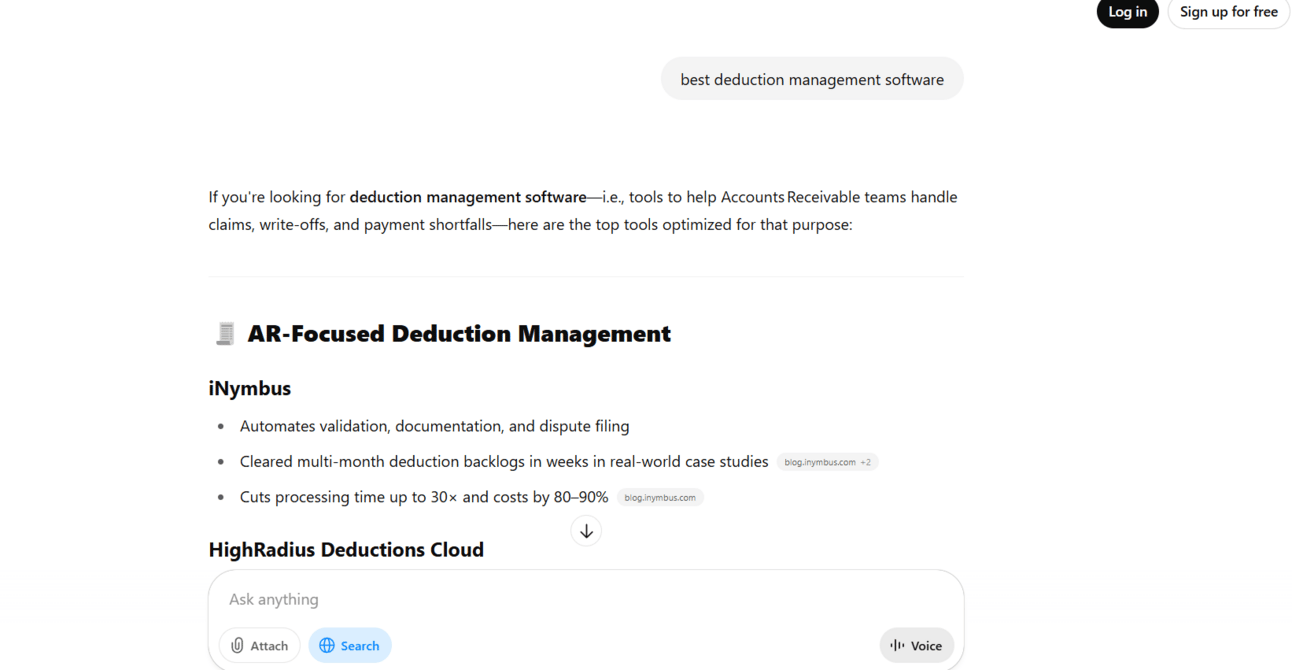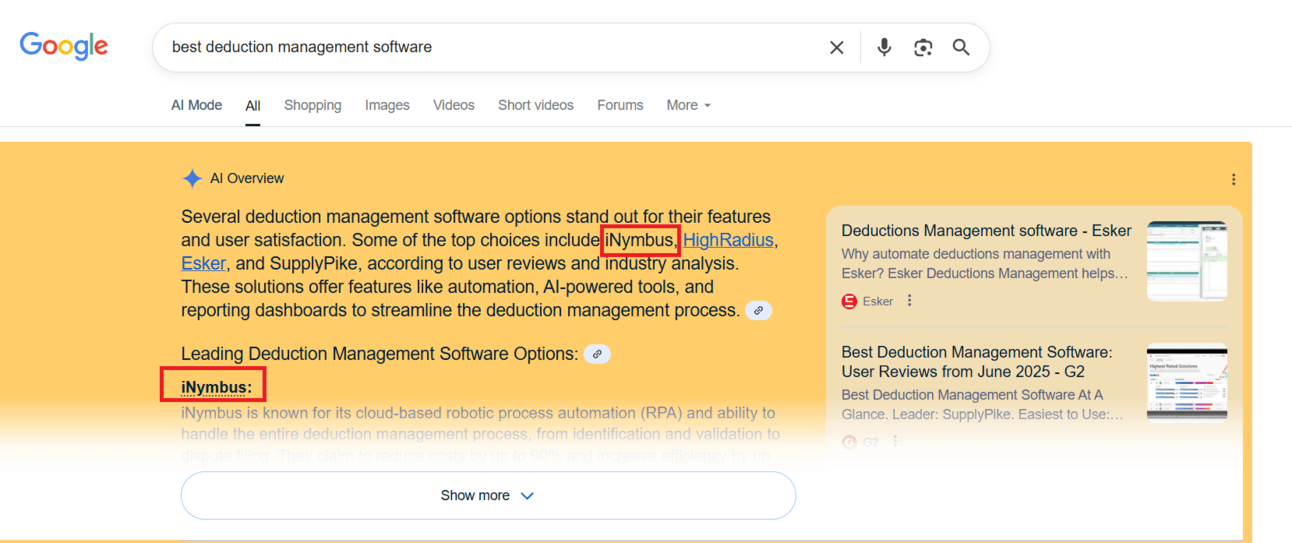- Top of the Funnel
- Posts
- What's working for LLM visibility right now?
What's working for LLM visibility right now?
8 real examples 👀
Go from low-paying gigs to your dream clients
Tyler interviewed top freelance writers like Lizzie Davey & Kiran Shahid
He asked: “how did you go from low-paying gigs to landing incredible clients?”
He took everything he learned and created the Break/through Bylines video course: a step-by-step system for landing work with clients like Shopify, HubSpot, and Zapier
Like it or not, LLMs are here to stay.
Which means we’re all going to be creating content aimed at boosting LLM visibility sooner or later.
The question is:
What’s that content going to look like?
I decided to find out 👀
The other week, I asked the members of Top of the Funnel if they’ve created any content specifically designed to influence LLM results. Then I followed up with everyone who said yes to find out what they’ve been doing…
Here’s what those fabulous folks shared with me (including some real examples of content that’s appearing in ChatGPT and AI Overviews right now).
Let’s dive right in…
📋 Listicles
Sukhdev Miyatra has had luck with a plain old listicle targeting the right term – ‘best deduction management software’.
“No one had written a ‘10 best X’ listicle in our niche”, Sukhdev told me. “I thought if I wrote that article it would show in LLMs, and it turns out it works – it appears in ChatGPT, AI Overviews and Google AI mode”


Aleksandra Beka Jovicic sees listicles as a great way to boost her clients’ LLM visibility, too.
Her and a client have been experimenting with creating super niche listicles – think “best [tool] alternatives for small e-commerce businesses on Shopify”.
This is a shift away from writing a “best [tool] alternatives” article, where her client’s product is listed as the best option for small e-com stores running on Shopify (one of their ICPs) and their competitors as the top pick for different use cases.
Instead, Aleksandra wrote a deep dive into how each platform stacks up for small Shopify stores – with specifics on why her client’s platform comes out on top for those users.
The hope is that this will influence LLM visibility when people search for that specific use case (given that people are making much more “conversational” searches within LLMs).
🔢 Stats round-ups
Serving up a bunch of juicy stats on a platter for the LLMs seems to be a good way to make it into their results.
That’s what Satabdi Mukherjee has found, anyway.
Her and her team published an article on AI customer service statistics on a client’s site in October 2024. By February it had driven:
111 organic backlinks from 50 referring domains
500+ sessions from Perplexity, ChatGPT, and Gemini
As Satabdi explained in a LinkedIn post: “AI models prioritize content that is well-organized, links to primary sources, and is widely referenced.”
So her and her team:
Sourced and linked to the original study for each stat
Structured the piece with clear sections (‘Growth of AI in customer service’, ‘Efficiency & productivity improvements’, etc.)
Visualised key stats with branded graphs and charts (so journalists and bloggers could embed or screenshot them instead of making their own)
The end result? A piece of content that’s easy for LLMs to understand, with plenty of backlinks showing that it’s a reliable reference worth showing to users.
🙅 Create AI-proof content
When I asked the brilliant Tory Gray what kind of content her and The Gray Dot Company team are experimenting with right now, she explained they’re taking two approaches:
Interactive content: Tools, templates, and assets that require a click (so people will always need to visit your site to use them)
Text that AI can’t easily replicate: Think hyper-recent news coverage or thought leadership that says something truly unique
In a nutshell, Tory’s AI-proof content strategy is: “Basically, not just text”
🎯 Answer super specific questions
Jess Joyce and her co-founder Nam Tran shared how they doubled a tattoo booking app’s AI/LLM traffic in less than 90 days in their newsletter yesterday 👀
And a big piece of the puzzle was answering specific questions with individual pages.
Here’s the playbook they used in their own words:
We noticed artists are now asking ChatGPT and AI tools for “best booking apps” or “how to manage tattoo clients.”
So we created direct-answer content:
• Problem-specific pages (e.g. “how to stop no-shows as a tattoo artist”)
• Targeted Reddit comments linking to helpful content
• Optimized long-tail terms likely to get surfaced in LLMs
LLM traffic jumped 225% as a result.
Conversions doubled.
Maurice Cherry has been taking a similar approach as Jess and Nam with the content he’s been creating for a global software company. The only difference is he’s been answering multiple long-tail questions on one long pillar page, rather than on individual pages.
Maurice told me:
“These pillar pages included a lot of questions for headlines (similar to a prompt someone might enter into a search engine or gen AI tool) and were usually pretty long – at least 8K-10K words. The longer the pages, the more information for search engines and LLMs to ingest.”
✍️ Optimise passages
The brilliant Claire Broadley told me she’s no longer just aiming to write a page that ranks – she’s writing specific passages aimed to get picked up by the LLMs, too.
She sent me an article she’s written about her approach to optimising passages in which she explains:
“We need to make individual sections of an article stand on their own. Assume any one of them could be picked as an answer to a question.”
How?
Claire suggests:
Using Bottom Line Up Front (BLUF): Instead of setting the stage and working towards a conclusion in each section of an article, start with the summary.
Optimising your headings: Make your headings clear, relevant, and helpful (i.e. not "Final Thoughts" or "In conclusion")
Optimising titles and meta descriptions for topics, not keywords: Think in terms of questions answered and information gained
Read more about Claire’s super interesting take on how to optimise for passages here
🧠 Think like an LLM
Couple ways they’re doing that:
Trying to influence how LLMs think about their clients’ products or services in relation to their competitors through specific writing styles, like parallel construction.
“For instance, we might plainly spell out side-by-side what our client’s product does differently to a competitor's in our content”, says Tyler. “We’re hoping that this will make it easier for the LLMs to make that distinction, which will influence the content it spits out”.
Tyler and his team have also been trying to influence the LLMs by using third-party quotes to back up the claims they make about their clients’ products.
So, instead of just saying “users love this specific feature of this product”, the Optimist team will add a quote from G2, Capterra, or Reddit that backs that point up.
This is obviously valuable for human readers. “But we also know LLMs are trained heavily on user-generated content from community spaces like review sites”, says Tyler. “So we’re thinking that this could also help amplify those positive product reviews within the LLM results”.
🌎 Go beyond your blog
LLMs are pulling most of their data from the likes of Reddit and Quora at the moment. So, if you influence the discussions on those forums, you’ll influence the LLM results…
That’s part of the playbook Jess and her co-founder Nam used to double that tattoo booking platform’s AI/LLM traffic in less than 90 days.
They explain:
We didn’t stop at blog posts.
We seeded answers across Reddit, SaaS directories, and niche forums.
Wherever artists vent, we were there – adding value, not selling.
Distribution matters as much as content.
Tory Gray is thinking along the same lines, too:
“LLMs love Reddit and online ‘word of month’ – like when users share that they like X product for Y use case”, she told me. “So, you want more users talking more about your brand/service/product in more places across the web.”
This is far from a definitive list of all the ways you can influence the LLM results.
And things are moving so fast there’ll probably be fifteen new best practices to follow by the time I finish this sentence.
But I hope this has given you a glimpse at the kind of content that folks are creating right now to boost brands' LLM visibility 👀
To recap, TOFU members have been aiming to show up in LLM results through:
Niche listicles
Stats round-ups
Content answering super specific questions
Interactive content
Hyper-recent news coverage
Genuinely unique thought leadership
And folks are also trying to land “standard articles” in the LLM results by:
Optimising for BLUF
Spelling things out for the LLMs (through techniques like parallel construction)
Backing up product claims with quotes from third-party sites
And content distribution – especially to the likes of Reddit and Quora – seems to be more important than ever…
HUGE shoutout to everyone who so generously shared their insights with us for this one:
You’re all total legends!
And last but not least…
🫵 How about you?
Have you been involved in creating content specifically designed to boost a brand's visibility in LLMs?
If you’re up for sharing, come join the convo over in Top of the Funnel.
 | TOFU Community Manager |